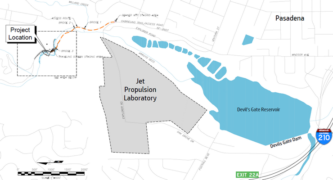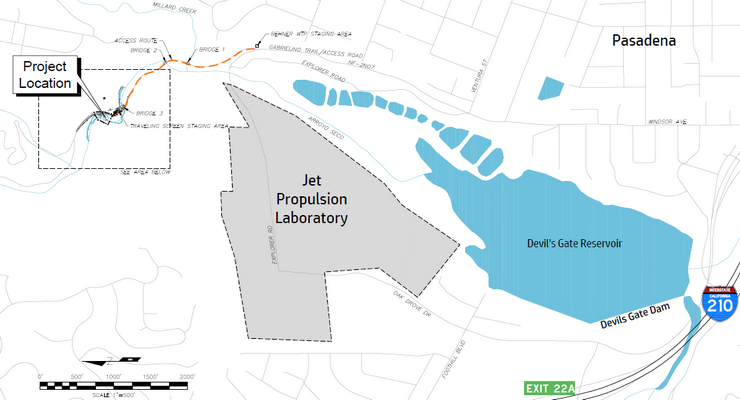In a letter to the city’s Hearing Officer, the Arroyo Seco (ASF) Foundation said it opposes plans by the Pasadena Water and Power Department (PWP) to upgrade facilities in the Upper Arroyo Seco damaged by the 2009 Station Fire.
Damage to the structures has greatly reduced the city’s capacity to divert water from the Arroyo Seco for spreading and pumping.
According to the city, the Arroyo Seco Canyon Project would improve infrastructure at the Arroyo Seco in order to boost PWP’s local supply resources and capacity for more robust water supply goals.
Officials say the project would improve local water resources through the Raymond Basis, increase water system reliability, lead to less dependency on imported water supplies from Northern California and the Colorado River, and allow PWP to treat and remove contamination from urban runoff.
The proposed improvements would allow for increased utilization of the city’s pre-1914 surface water rights to the Arroyo Seco.
A modification to a conditional use permit (CUP) was scheduled to be heard by the Hearing Officer on Wednesday. A CUP is required for any improvements in the area, which is within the Open Space Zoning District.
“Throughout the long and voluminous environmental review process, PWP and its consultants have been defensive and self-serving rather than responsive and objective,” wrote ASF Managing Director Tim Brick.
“Stripped to its basics, ASCP is a project that will degrade an important stream, habitat and wildlife corridor to enable PWP to pump more water from a severely declining groundwater basin,” Brick wrote.
As part of the project, an existing diversion and intake structure would be demolished and a new diversion weir would be built.
A diversion weir is built across a river or canal to raise the water level, or in parallel to divert the water.
A new intake would be constructed in the same location within the Arroyo Seco and be equipped with a trash rack and fish screens to prevent fish from entering the conveyance system to the spreading basins.
According to Brick, the ASCP should not contribute to a reduction in the groundwater levels in the Monk Hill subarea and the Raymond Basin.
Brick also said the city needs to provide an environmental flow or bypass to protect fish and aquatic species now, rather than at some distant uncertain time and supports an in-stream flow approach that would maximize environmental benefits and groundwater replenishment should be implemented rather than using inefficient spreading basins.
Local residents also opposed the project in correspondence with the city.
“Rather than allowing PWP to expand its spreading basins which need constant maintenance to function properly, we can once again allow the living river and stream waters to percolate naturally into the aquifer below,” said longtime local activist Christle Balvin.
“We can foster the return of native fish and allow our children to once again search for the Arroyo toad along our river banks. We can picnic by the stream and help our children appreciate the importance of running water and the great natural gift that the Arroyo and its tributaries have given us,” Balvin wrote.
Pasadena resident Ken Kules said “the Arroyo Seco Canyon Project and associated increased groundwater pumping resulting from earned pumping credits will have a significant adverse impact on the Raymond Basin groundwater condition,” wrote Pasadena resident Ken Kules.
The city of Pasadena owns the right to divert up to 25 cubic feet per second (cfs) of surface water from the Arroyo Seco for direct use or to spread for percolation in spreading basins for groundwater pumping credits from the Raymond Basin,” according to a city staff report.
“The proposed project more fully captures the city’s allocation of up to 25 cfs to augment local groundwater supplies,” according to the report.
Backers of the project also hope to enhance recreation and habitat by better using Pasadena’s longstanding water rights and adding management tools to enhance the groundwater basin.
“It is with regret that we offer these critical comments on the Arroyo Seco Canyon Project,” Brick wrote. “ASF initiated the project more than 12 years ago and succeeded in obtaining a $3.3 million grant from the State of California’s Integrated Water Resources Management Program. We worked with Pasadena in the early planning stages of the program and recommended completing a full EIR for the project back in 2012, rather than just a Mitigated Negative Declaration. Pasadena rejected our recommendation, failed to meet the grant timeline, lost the grant funding and eliminated the environmental improvements that we supported.”














 0 comments
0 comments



